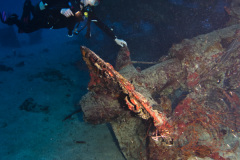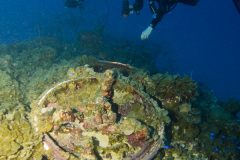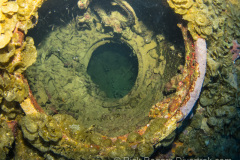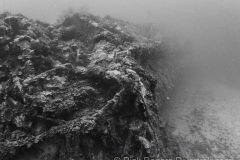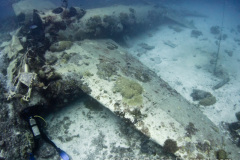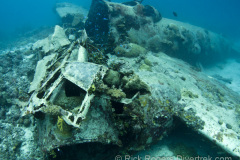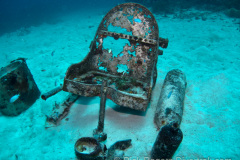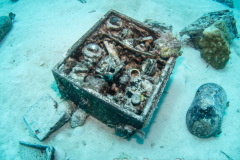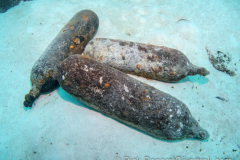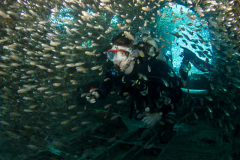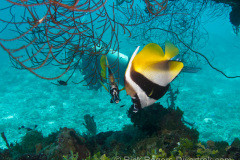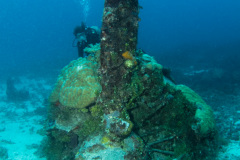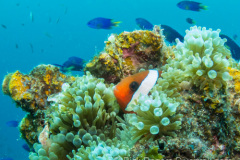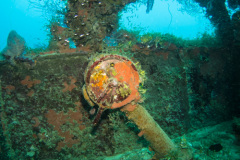Aug 3, 2013

I’ve always been interested in submarines, beginning when I found out that my great-grandfather served in the Royal Navy on the ill-fated submarine HMS E24 in WWI. So when I asked about the I-169 Capt. Nelson said “We’re here to make your dreams come true”.
Submarine I-169 (depth 90′ deck to 140′ bottom).
The I-169 story is a tragic one. As an air alarm sounded on April 4, 1944 (post Operation Hailstorm) the I-169 dove quickly for cover, as there were no sea pens at Truk. Even today, all that remains of the former submarine base is an unassuming concrete pier onshore. In the ensuing emergency dive a ventilation valve was left open and the control room flooded. The crew perished when subsequent rescue attempts failed. Later the Japanese depth-charged the submarine to prevent it from falling into American hands, which completely destroyed the bow and conning tower sections.
Today the sub’s outer hull is badly corroded, leaving the inner pressure-hull exposed in many places.
Mitsubishi G4M3 twin-engine attack bomber, the “Betty Bomber” (depth about 50-60′).
How often do you get a chance to dive a Japanese bomber? This bomber crashed a few hundred meters short of the Etten airfield. In the crash its nose was broken off and the engines were thrown forward nearly 100 m off the port side. It’s not known whether or when it was shot down (it has bullet holes) or crash-landed. The fish keep it pretty clean and shiny.
Kensho Maru, passenger-cargo ship (superstructure at 60′, deck at 80′ to max depth 120′).
This is a popular dive, as its sheltered, relatively shallow and has good viewing opportunities in and outside the wreck. The main attraction is the easily accessible and photogenic engine room.
Special thanks to co-Captains Nelson & Todd, guides Ken, Kent and Sam, and the whole crew of the Odyssey for making this trip so memorable and enjoyable. Its difficult to imagine a more professional and fun group to be with.
Travel & Dive Tips:
Divers come to these Islands for the Diving. There are no beaches to speak of or other types of typical tourist attractions. The infrastructure is poor, but progress is slow and the government has been attempting to fix this for a number of years. There is a lot of missionary work in the area.
If you’re travelling a long way, its ideal to arrive early the day before to rest and rehydrate after long hours flying. The captain did tell me of increasing numbers of divers getting Type I DCS (skin rashes), likely due to exhaustion & dehydration from flying. I did a layover at Hawaii for a day to help readjust, in addition to arriving early.
Nitrox certification will come in handy if you plan on doing multiple dives throughout the week. The Odyssey banks their Nitrox at 30%. My log book shows depths down to about 100 ft or deeper about 50% of the time. Regardless, know how to work your dive computer, as you will have to alter the partial pressure settings (if you choose to do the deeper dives, such as the Hoki Maru -I recorded 137 ft) or the gas settings for deeper dives (eg. Sanfrancisco Maru). In some dives, decompression becomes a part of the dive plan, either by choice or if you’re not careful about your accumulated Nitrgogen.
Related Articles:
The Hell Ships of Truk Lagoon.

